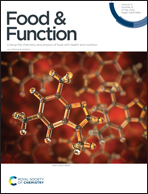Dietary phenolic-type Nrf2-activators: implications in the control of toxin-induced hepatic disorders
Abstract
Numerous studies have exemplified the importance of nuclear factor erythroid 2-related factor 2 (Nrf2) activation in the alleviation of toxin-induced hepatic disorders primarily through eliminating oxidative stress. Whereafter, increasingly more efforts have been contributed to finding Nrf2-activators, especially from dietary polyphenols. The present review summarized the phenolic-type Nrf2-activators published in the past few decades, analyzed their effectiveness based on their structural characteristics and outlined their related mechanisms. It turns out that flavonoids are the largest group of phenolic-type Nrf2-activators, followed by nonflavonoids and phenolic acids. When counting on subgroups, the top three types are flavonols, flavones, and hydroxycinnamic acids, with curcuminoids having the highest effective doses. Moreover, most polyphenols work through the phosphorylation of Nrf2. Besides, mitogen-activated protein kinases (MAPKs) and protein kinase B (Akt) are the frequent targets of these Nrf2-activators, which indirectly mediate the behavior of Nrf2. However, current data are not sufficient to conclude any structure-activity relationship.

- This article is part of the themed collection: Food & Function Review Articles 2022


 Please wait while we load your content...
Please wait while we load your content...